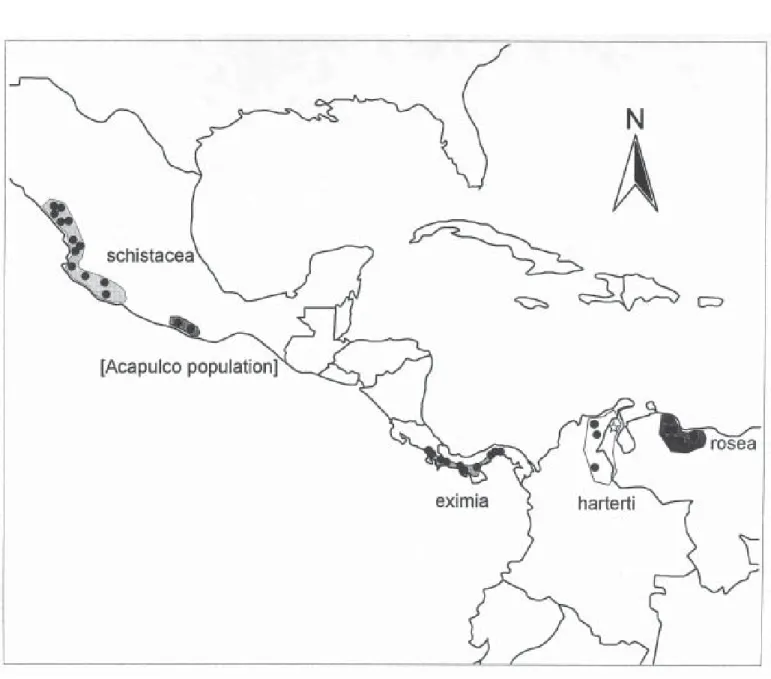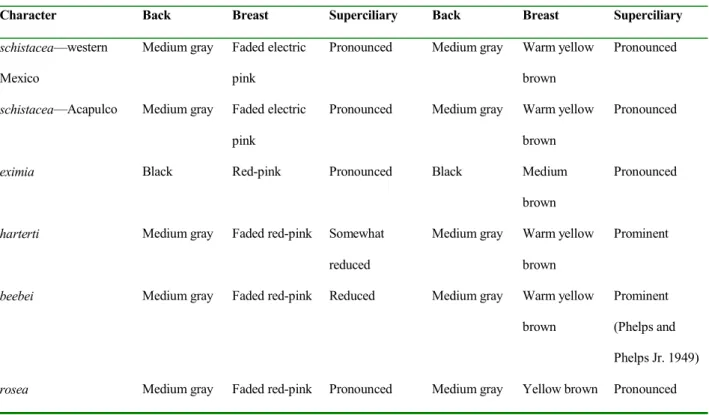(RHODINOCICHLA ROSEA) COMPLEX OF MESOAMERICA (AVES:
PASSERIFORMES)
1 Department of Ecology and Evolutionary Biology, Natural History Museum, The University of Kansas, Lawrence,
Kansas 66045 USA.
2 Current Address: Ornithology Department, Academy of Natural Sciences, Philadelphia, Pennsylvania 19103 USA 3 Museo de Zoología, Facultad de Ciencias, UNAM, Apartado Postal 70-399, México, D. F. 04510 México.
Abstract
Patterns of differentiation and geographic variation among populations of the Rhodinocichla complex are described. We document the existence of a heretofore unreported population in the vicinity of Acapulco, Guerrero, Mexico. The species occurs in 4-6 allopatric populations, each of which has unique characters that make it diagnosable. We recommend that the complex be considered a single biological species, but at least five phylogenetic species.
Key words:
Resumen
Se describen los patrones de diferenciación y variación geográfica entre poblaciones del complejo de Rhodinocichla. Se documenta la existencia de una población antes no conocida en los alrededores de Acapulco, Guerrero, México. La especie se encuentra dividida en 4-6 poblaciones alopátricas, cada una de las cuales tiene caracteres únicos que permiten diagnosticar a la población. Se recomienda que el compejo sea considerado como una sola especie biológica o como por lo menos cinco especies filogenéticas.
Palavras-chave:
Biota Neotropica v4 (n2)– http://www.biotaneotropica.org.br/v4n2/pt/abstract?short-communication+BN02304022004 A. Townsend Peterson1, Nathan H. Rice1,2, and Adolfo G. Navarro-Sigüenza3
Date Received: 04/16/2004
Bermingham 1997).
Equally interesting, and even less-studied regarding Rhodinocichla, however, are the details of their geographic distribution and morphological variation. The species’ dis-tribution is patchy, constituting a series of disjunct popula-tions (Figure 1): the form schistacea of Sinaloa to Colima in western Mexico, a previously unreported population in Guerrero (in the surrondings of the Laguna de Tres Palos, a coastal lagoon very close to Acapulco), eximia of Pacific-slope Costa Rica and Panama, beebei and harterti of north-eastern Colombia and northwestern Venezuela, and nomi-nate rosea of northern Venezuela. Each population may prove genetically isolated from all others. Although geo-graphic differences among populations are striking, with variation in size, shape, and coloration, geographic varia-tion in the genus has not been treated apart from the origi-nal descriptions of subspecies. The purpose of the present contribution is therefore to summarize variation of charac-ters of coloration and morphology among Rhodinocichla populations.
Methods
To permit detailed comparisons, we assembled 171 study skins of Rhodinocichla from the following museums for study: Academy of Natural Sciences of Philadelphia, Field Museum of Natural History, Carnegie Museum of Natu-ral History, Louisiana State University Museum of NatuNatu-ral Science, Southwestern College, U. S. National Museum of Natural History, Occidental College Moore Laboratory of Zoology, University of California Museum of Vertebrate Zoology, University of Kansas Natural History Museum, Delaware Museum of Natural History, and the University of Michigan Museum of Zoology.
terns of structure for the morphological measurements and color variation were analyzed using cluster analysis.
Results
A previously unknown population of Rhodinocichla from the vicinity of Acapulco and nearby Laguna de Tres Palos, Guerrero, Mexico (ca. 16.8ºN 99.7ºW), was represented by 19 specimens (15 Delaware Museum of Natural History, 3 Occidental College Moore Laboratory of Zoology, 1 U. S. National Museum of Natural History). This population may be allopatric from the populations of the west because no specimen is known between Río Nexpa, Michoacán, and Tecpan de Galeana, Guerrero, west of Acapulco. Many of these previously undocumented specimens were collected by Sóstenes Romero, a local collector from Acahuizotla, who was employed by Allan R. Phillips for many years. Further studies along the coastal plain of Michoacán and western Guerrero will be necessary to determine the degree of geographic continuity of these populations. Because of its possible allopatry, this population was maintained sepa-rate in our analyses.
Table 1. Summary of plumage characters in males and females of subspecies of Rosy Thrush-tanager populations.
Males Females
Character Back Breast Superciliary Back Breast Superciliary
schistacea—western
Mexico
Medium gray Faded electric
pink
Pronounced Medium gray Warm yellow
brown
Pronounced
schistacea—Acapulco Medium gray Faded electric
pink
Pronounced Medium gray Warm yellow
brown
Pronounced
eximia Black Red-pink Pronounced Black Medium
brown
Pronounced
harterti Medium gray Faded red-pink Somewhat
reduced
Medium gray Warm yellow
brown
Prominent
beebei Medium gray Faded red-pink Reduced Medium gray Warm yellow
brown
Prominent
(Phelps and
Phelps Jr. 1949)
having shallower bills), and in males in tarsus length (Acapulco populations having shorter tarsi). Although these tests are based on relatively small samples and bill depth is not a particularly precise measurement, they may indicate genetic isolation of the two populations.
We used a cluster analysis of population means for the six measurements to evaluate overall similarity in size and shape of the different populations. In the analyses for both sexes, the two Mexican populations were most similar in morphometric space. Central and South American popu-lations were most similar to each other, and the two clusters were only distantly connected, for an overall pattern of ((Western Mexico, Acapulco), (Costa Rica, South America)). Hence, overall shape features of the Mexican populations separated them in morphological space from the remaining populations.
Striking variation exists among populations in plum-age coloration. Males from western Mexico and Acapulco have back and flanks medium gray and breast faded electric pink; males from South American populations are similar, although breast color could be described as faded red-pink. Males in the intervening populations of Costa Rica and Panama, however, are very distinctive, with back and flanks black, and the breast bright red-pink. The superciliary line is marked in Mexican and Central American populations, some-what less obvious in the populations of northern Venezu-ela, but obsolete in the intervening populations of Colom-bia and northwestern Venezuela. Variation in coloration of females parallels that of males, with similar shades of gray and black on back and flanks; the breast and throat were warm yellow brown in individuals from Mexico, Colombia, and northwestern Venezuela, slightly less warm in northern Venezuelan individuals, but much darker and stronger in color in birds from Central America. Therefore, overall
plum-(Peterson 1991a, 1991b). Strangely, though, in Rhodinocichla, specimens in juvenal plumage or molting into a first basic plumage were no more likely to have light-colored bills than adults (Mann-Whitney U-tests, all P > 0.30). Also, geographic variation in mandible coloration was not statistically significant (Kruskal-Wallis tests, P > 0.05); both sexes did show significant among-population differ-ences in maxilla coloration (P < 0.05). Therefore, although bill color variation observed in Rhodinocichla apparently does not represent ontogenetic variation, geographic dif-ferences of unknown significance do exist.
Discussion
Our analyses illustrate the unpredictable nature of geographic variation in Rhodinocichla. All features exam-ined, including measurements, plumage coloration, sexual size dimorphism, and bill coloration show statistically sig-nificant variation among populations. Characteristics of each isolated population seem randomly assorted with regard to other characteristics and populations, and clear geographic trends or predictable combinations do not appear to exist.
An important aspect of any modern assessment of geographic variation is a discussion of species limits. The two species concepts currently used in ornithology—the phylogenetic species concept (PSC) and the biological spe-cies concept (BSC)—often yield different taxonomies. In the present case, each of the four major geographic isolates (Mexico, Costa Rica and Panama, Colombia and northwest-ern Venezuela, and northnorthwest-ern Venezuela) is clearly diagnos-able, and should be considered a separate species under the PSC. Indeed, from Figure 2, even the Acapulco popula-tion appears diagnosable, although plumage differences are lacking. Pending more detailed study of longer series, this population may warrant description as a separate taxon.
The BSC, however, uses as its principal criterion re-productive isolation, which in a disjunctly distributed spe-cies such as this is impossible to test directly, so decisions are far more nebulous. However, given the conflicting na-ture of variation in different character sets (e.g., Mexican populations are most distinctive in terms of size and shape, Central American populationsin terms of coloration), de-tection of limits is difficult. Moreover, given that geographic variation within other Emberizid species is often of the mag-nitude of the differences observed without apparent repro-ductive isolation, subdivision of this complex may not be warranted at the present time(Remsen et al. 1991).
A more basic question is that of why disjunct distri-butions such as the present example exist. Large range dis-junctions, coinciding at least in part with those described herein, are known in several other taxa: Ara militaris (north-ern vs. south(north-ern populations), Cyanocorax yncas (north-ern vs. south(north-ern populations), Cyanocorax dickeyi vs. C. mystacalis, Cypseloides storeri vs. C. cryptus, Lophornis brachylopha vs. L. delattrei, Thalurania ridgwayi vs. T. colombica, and Zenaida asiatica (northern vs. southern populations). The apparent western Mexico - Guerrero dis-junction is mirrored by patterns in the San Blas Jay (Cyanocorax sanblasianus), also for unknown causes. Unlike the better-known disjunctions of many taxa between the isolated montane forests of the Andes, the Guianan Shield, and the mountains of southeastern Brazil, these dis-junctions lie in the midst of seemingly continuous and ap-propriate habitat.
Acknowledgments
We thank the curators of the collections listed above for the generosity and dedication in providing loans of specimens for this study. We thank J. Dan Webster and Miguel Lentino for open sharing of data and information.
Literature Cited
EISENMANN, E. 1962. On the systematic position of Rhodinocichla rosea. Auk 79:640-648.
LESSON, R.-P. 1832. Illustrations de zoologie, livre 2. A. Bertrand, Paris.
NAVARRO-SIGÜENZA, A. G., A. T. PETERSON, P. ESCALANTE-PLIEGO, and H. BENITEZ-DÍAZ. 1992. Cypseloides storeri: a new species of swift from Mexico. Wilson Bulletin 104:55 64.
PETERSON, A. T. 1991a. Geographic variation in beak color maturation rates in Gray breasted Jays. Condor 93:448 452.
PETERSON, A. T. 1991b. Sociality and ontogeny of colora-tion in the blue and black jays (Cyanocorax). Wilson Bulletin 103:59 67.
PHELPS, W. H., and W. H. PHELPS, Jr. 1949. Seven new subspecies of birds from Venezuela. Proceedings of the Biological Society of Washington 62:185-196.
REMSEN, J. V. Jr. 1984. High incidence of “leapfrog” pattern of geographic variation in Andean birds: implications for the speciation process. Science 224:171-173. REMSEN, J. V. Jr., O. ROCHA O., C. G. SCHMITT, and D. C.
SCHMITT. 1991. Zoogeography and geographic varia-tion of Platyrinchus mystaceus in Bolivia and Peru, and the circum-Amazonian distribution pattern. Ornithología Neotropical 2:77-83.
SEUTIN, G., and E. BERMINGHAM. 1997. Rhodinocichla rosea is an emberizid (Aves; Passeriformes) based on mitochondrial DNA analyses. Molecular Phylogenetics and Evolution 8:260-274.
SKUTCH, A. F. 1962. On the habits of the Queo, Rhodinocichla rosea. Auk 79:633-639.
WEBSTER, J. D. 1988. Skeletons and the genera of tana-gers. Proceedings Indiana Academy of Sciences 98:581-593.
Title: Geographic Variation in the Rosy Thrush-tanager (Rhodinocichla rosea) Complex of Mesoamerica (Aves: Passeriformes)
Authors: A. Townsend Peterson, Nathan H. Rice, and Adolfo G. Navarro-Sigüenza
Biota Neotropica, Vol. 4 ( number 2): 2004
h t t p : / / w w w. b i o t a n e o t r o p i c a . o r g . b r / v 4 n 2 / p t / abstract?short-communication+BN02304022004
Date Received: 04/16/2004 - Revised: 06/24/2004 Accepted: 07/01/2004

